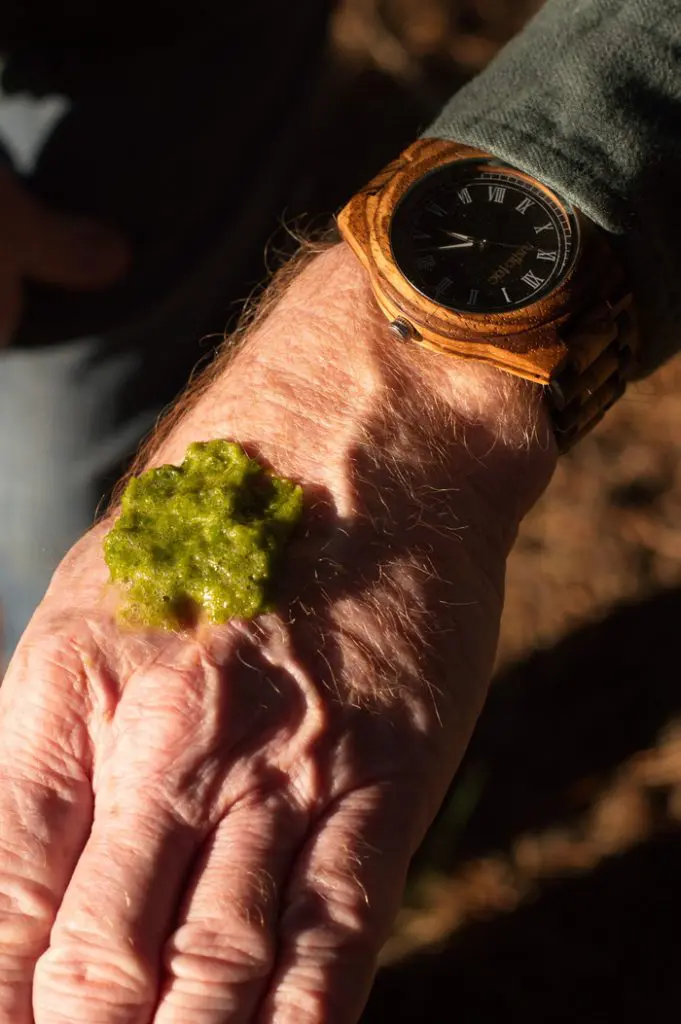Welcome to Herb Camp 2020! In this second of three weeks of herb camp, the theme is “What do you have in your hand?” What do you have that is growing around you, that you need to heal or to inspire? In today’s Herb Camp Challenge we’re going to make a plantain poultice to pack in a tin, and keep in your glove compartment, first aid kit, or travel kit. Plantain is the best herb for stings, boils, bites, and infections. It draws venom from the skin and removes the pain.
Note: If you get stung by a bee, don’t try to pinch the stinger and pull it out. The barbs will pump the venom deeper into your body. Instead, use the edge of your nail, a credit card edge or other firm object and scrape the stinger out of your body. Then apply a plantain poultice immediately to draw out the venom.
Ant bites are predominantly formic acid. Using baking soda in a paste will neutralize the acid and remove the pain. But bee stings contain a complex mixture of enzymes, peptides, and smaller molecules that cause pain and swelling in the body. Plantain is the best remedy to draw these quickly out of the body.
The longer the venom is in the body the more pain, swelling, and inflammation can take hold, so having a plantain poultice close at hand can minimize the damaged tissue and bring fast relief.
If you are on a picnic or in the woods, fresh plantain might be close by, along the trail. But if you have a plantain poultice in your travel kit, you won’t have to look for a plantain plant in the middle of a crisis. If you don’t have the ready made version, grab a plantain leaf. Make a positive ID, you don’t want to get this one wrong.
How to make a spit poultice
Every child should know this skill and be able to use it without supervision. Teach your children and grand children to identify Plantago major and P. lanceolata.
How to Make a Plantain Poultice using dried plantain
This recipe is also in the Herbal First Aid Travel Kit Masterclass. Enroll in that masterclass here.
PrintPlantain Charcoal Poultice
This recipe is also in the Herbal First Aid Travel Kit Masterclass. For more great DIY first aid projects designed with travel in mind, enroll in that masterclass.
Ingredients
- 2 tablespoons plantain, dried
- 1 tablespoon lavender flowers, dried
- 2 tablespoon comfrey leaf, dried
- 1 tablespoon activated charcoal
- 3 large tea bags, press and seal
Instructions
- Add the ingredients to a bowl. Mix well with a whisk, being careful not to make the charcoal powder airborne as you mix. Add 2 tablespoons full of the mixture to each tea bag.
- Cover your ironing board with a washable towel. The charcoal tends to leak in these before the tea bag is sealed.
- Set your iron to “cotton” and press the closure of each tea bag to seal it. Place the tea bags in a tin with a tight lid, and label the tin.
- To use:
- Use this poultice for bites, spider bites, bee stings, where the bite site is swollen and hard. This is also useful for slivers and boils. The herbs are drawing and antiseptic. The sooner the poultice is applied the less tissue damage from the venom.
- Put the tea bag in a heat proof mug or cut. Pour boiled water of the tea bag until the tea bag is just moistened, but not dripping. Allow it to sit until the bag is cool enough to handle but still warm. The tea bag should be saturated but not dripping. Press any excess moisture out of the bag so that it doesn’t drip.
- Place the still warm tea bag directly on the injury being careful not to burn the skin. Cover with a warmed wash cloth. Hold on the site of the bite or sting for 45 to 60 minutes or longer. The poultice can be rewarmed and used one more time.
- Remove the poultice. Wash the site with cold water. Repeat as often as needed until the swelling and pain is resolved.
Notes
For bites from ticks and poisonous spiders take the person to the hospital emergency. If possible take the spider or tick with you so that it can be tested for disease.
If you want to add essential oils to this poultice, wait till the poultice has been heated in boiling water, then add the essential oils just before you apply it to the bite. Essential oils will evaporate when heated.
Your assignment:
Make a plantain poultice using dried plantain. Take a photo of your completed plantain poultice. Share your photo inside the Facebook group in this thread.
If you are not in the Facebook group upload your photo to a photo sharing site and leave the link in the comments on this post.
Note: Click the small arrow on the LEFT to go to the previous day’s Herb Camp Challenge. Click the small arrow on the RIGHT to go to the next day’s Herb Camp Challenge.




I don’t have any dried…yet. but I’m going to go out and pick some fresh for a spit poultice for my bites and also pick enough to fill a dehydrator shelf so I can make your recipe with lavender which I also have access to.
I walked all over our property, sadly, there is no plantain on it.
I do have marigolds popping up all over there is still some yarrow but no plantain.
I will have to either purchase some or harvest some the next time we are in the mountains.